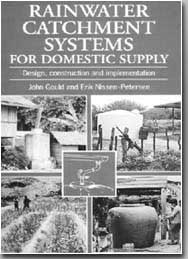|
Rainwater Catchment Systems for Domestic Supply: Design, Construction and Implementation,
The book is truly an international effort, in terms of the contributors as well as content. With articles authored from various parts of the world, the book documents rainwater harvesting systems and efforts across the continents of Africa, Asia, Australia, Europe, and the US. As is the case with other resources, there is tremendous inequity between access to good quality water between the rich and the poor. The adoption of rainwater catchment (harvesting) systems offers a practical solution to augment water availability as well as conserve the scarce source. The advantages of harvesting rain go beyond meeting demand requirements and conservation: these systems can also be used for urban flood control as is being practiced in cities such as Tokyo in Japan. A number of countries are rediscovering their water harvesting traditions. The reasons are not hard to find: one is the increasing realisation that current prevalent water supply systems just cannot cope up with the demand, and the other, that there is tremendous catchment area available the world over which can be tapped to capture rain. The essential components of a rainwater harvesting system are: the rainfall, the catchment area and the people who will harvest the rain. The objectives of this book is to provide an updated review of the recent developments as well as the lessons learnt in utilising rainwater catchment systems for domestic supply, and to look at future technological opportunities. It provides a broad overview of construction procedures that have been adopted. It describes the features of rainwater catchment systems, the components of the system and their design and the materials that can be used. It also addresses an important issue – that of rainwater quality and how this can be improved. The appendices at the end of the book are an important value addition. These include a construction manual, design information and computer modeling. The book is a must-read for persons and organisations involved in water-related issues. |

